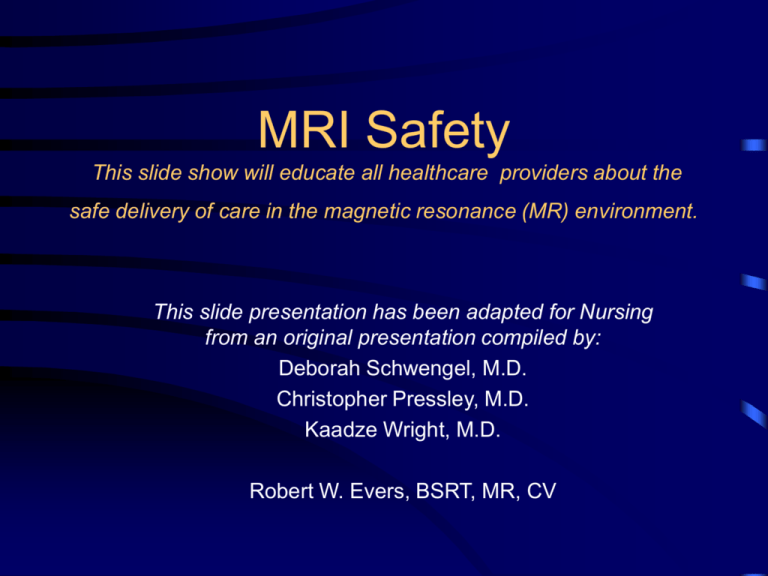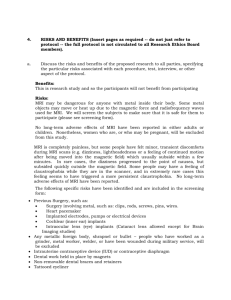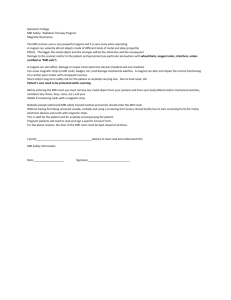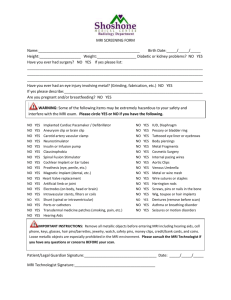Safety in the Magnetic Resonance Environment
advertisement

MRI Safety This slide show will educate all healthcare providers about the safe delivery of care in the magnetic resonance (MR) environment. This slide presentation has been adapted for Nursing from an original presentation compiled by: Deborah Schwengel, M.D. Christopher Pressley, M.D. Kaadze Wright, M.D. Robert W. Evers, BSRT, MR, CV THE MAGNETIC FIELD IS AT FULL POWER ALWAYS ….IT IS ALWAYS “ON”. EMPLOYEE SAFETY ALL EMPLOYEES MUST BE SCREENED TO WORK IN A MAGNETIC FIELD ENVIRONMENT JUST LIKE THE PATIENTS. NO EXCEPTIONS. MRI PROCEDURE SCREENING FORM To ensure patient safety, completion of the MRI screening form is required prior to every MRI scan. Units can assist & expedite the MRI's triage process by completing this form in advance and faxing to 2-8582. This form is located online at: http://www.rad.jhmi.edu/requisitions.htm MRI Screening Sheet All Patients will need this form filled out before an MRI can be done. Ideally, the form should be filled out by: a. The Patient If the patient cannot fill it out: b. Family Members If there are no family members: c. Referring MD What to do in an Emergency • If there is a Patient Emergency in MRI… – GET THE PATIENT OUT OF THE ROOM – NO CODE OR CODE LIKE PROCEDURES WILL BE RUN IN THE MRI ROOM. BURNS • It is “possible” for patients to get 1st, 2nd, or even 3rd degree burns in an MRI if items such as ECG cables are looped and are touching the patients skin (even if these devices are MRI compatible). – All “cables” should not touch the patients skin directly, and should NOT be in a LOOPED configuration. What can you take into a magnetic field? • ONLY ITEMS THAT ARE MRI COMPATIBLE. Such as… – Brass – Aluminum – Plastic – IF YOU ARE NOT SURE IF AN OBJECT IS MRI SAFE…DON’T TAKE IT INTO THE ROOM. ASK A TECHNOLOGIST!!!!!!!! Magnetic Field • What “objects” can you take into a magnetic field? Anything that doesn’t contain iron. To be safe…TAKE NOTHING INTO A MAGNETIC FIELD. Work closely with the Technologist who works in that type of environment each day. Question Everything. Site Access Restriction: Screening • All patients presenting for a non emergent scan must be screened by two MR personnel, including one with level 2 qualifications. • A detailed history on possible implants or metallic objects must be obtained in writing and signed by appropriate medical licensed personnel. • Do not rely on verbal history alone. Characteristics of the Magnetic Field • the force of the field is measured in tesla (T); a typical scanner is approximately 1.5- 3.0 tesla • the force of the field is greatest at the periphery of the magnet. This FORCE INCREASES as you move closer to the magnet. • NOT ALL MAGNETS ARE THE SAME FIELD STRENGTH, THUS THEIR “ATTRACTIVE FORCES” WILL BE DIFFERENT. Biologic Effects of the Static Magnetic Field on Persons in its Proximity questions to consider • does the field have long term deleterious effects such as increasing the risk of neoplasm? • does the field have effects on the patient which alter our monitoring? • does the field have effects on implanted medical devices which are non-ferromagnetic and “MR safe”? To date there is no clear and convincing evidence that exposure to high magnetic forces in the MR environment increases the risk of cancer. Effects of the Static Magnetic Field on Implanted Medical Devices Although certain devices such as implanted pumps may be MR compatible, there are still important considerations in this patient population. Determining if a medical device is safe in the MRI environment • The MRI staff are always equipped with the latest information on device safety. • Questions should be directed to the chief MRI technologist. Pacemakers There several reports in the literature describing the occurrence of sudden death in the MR for patients with implanted (but MR compatible) pacers. To date the mechanism of these fatalities is unclear but is thought to be secondary to the induction of fatal arrythmias. Therefore pacemakers are currently a contraindication to MR scanning. Forces in the MR Environment • Magnetic field – missile effect: TRANSLATION – rotational effect: ROTATION/TORQUE Translational Force • this term describes the force which attracts ferrous objects to the center of the magnetic field • may act to transform ferrous objects into missiles as they accelerate toward the magnet • the force is greatest when the difference in field strength across the object is greatest; where delta T or difference in field strength from point A to point B is maximized A B Rotational Force • this force relates to the North - South orientation of the scanner’s magnetic field • ferrous objects will attempt to align their long axes with this orientation • this force will rotate objects until they are aligned and is greatest at the very center of the field (unlike the translational force which is greatest where the difference in magnetic field across the object is greatest) Another danger in MRI QUENCH! • MR scanners are supercooled with inert gases such as helium. • If these cryogens BOIL OFF either intentionally or unintentionally, a quench has occurred. THIS IS EXTREMELY BAD. • An INTENTIONAL quench is done in an emergency to run the magnetic field to ZERO in order to remove a projectile/patient from the scanner in extreme emergencies. • If a quench occurs, remove all staff from the room immediately Another danger in MRI QUENCH! • THE WORRY WITH A QUENCH IS THE POTENTIAL FOR ASPHIXIATION AND FROST-BITE TO THE HEALTH CARE WORKER AND PATIENT. Pregnant Patients or Personnel: • Pregnant patients regardless of trimester are only scanned if the results of the study will change the care of the patient. • Pregnant MR personnel are encouraged not to stay in the room during the scanning process. Introduction to the zone system for maintaining safety in the MRI suite Site Access Restriction – All personnel with access to MR must have either level 1 or level 2 qualifications. – Level 1 personnel are minimally trained in MR safety and can ensure their own safety and the safety of a patient in the MR environment. – All JHH anesthesiologists must have level 1 qualifications. Site Access Restriction • Level 2 personnel are extensively knowledgeable about the MR environment, the potential hazards of the agents and equipment used, and MR safety precautions. • The MR safety director, and all MR radiology technologists are level 2 personnel. Safety Zones • Zone 1 : This is a public access area with no restrictions. • Zone 2 : This is a semi restricted area where patients and hospital staff can interact. • Zone 3 : This area is completely physically restricted from non MR personnel especially the general public. Remember this mnemonic: MRI = Metal Results (in) Injury The End








